► Puma takes on crossover rivals
► New 2008, Juke v2.0 and T-Cross
► Which small car brings the funk?
Small cars used to be small cars. Now, they're compact crossovers and are largely unexceptional... until now. Ford's new Puma has arrived, and is here to take on the small-SUV stalwart Nissan Juke, the equally fresh-faced Peugeot 2008 and chunky VW T-Cross. Bring on the funk.
Ford Puma: pre-flight briefing
Why is it here?
Because the Fiesta's a riotously successful small car and this, Ford hopes, will be a riotously successful compact crossover. There are practical touches – you get an under-boot storage area for wet and filthy clothes, and a mild-hybrid system – but Ford's shooting for your heart with the Puma's design and dynamics.

Any clever stuff?
The hybrid system isn't a powerful one (the battery's tiny and there's no plug-in capability or EV-only range) but it is handy, helping the already punchy 1.0-litre triple feel punchier still and gently massaging fuel economy in the right direction. There's also plenty of handy stuff like auto-dip main beam, adaptive cruise and auto parking.
Which version is this?
A 1.0-litre Puma Titanium (£20,845) with blue paint (£650), comfort pack (heated seats and steering wheel, £300) and the driver assistance pack (£900). On-the-road price is £22,945 for this car. Another £700 ups power to 153bhp – you'd be mad not to.
Read our Ford Puma review here
Nissan Juke: pre-flight briefing
Why is it here?
Because you can't put together a group test of compact cross-overs without the Nissan the kicked off the phenomenon, a class VW reckons will grow from today's 6.4 million units per year globally to more than 10 million over the next decade. Bigger, lighter and better than Juke 1, can Juke 2 hang onto its crown?

Any clever stuff?
Not really, though the Juke's well-equipped in the higher trim levels. Those Bose headrest speakers are worth splurging for, giving your sanity a fighting chance against the Nissan's at times onerous road noise. A twin-clutch 'box has replaced the old Juke's ponderous, frustrating CVT, making going automatic an actual option now.
Which version is this?
This is actually our long-term test Juke; a 1.0-litre DiG-T Tekna+ (from £23,895), hence the big wheels, the standard touchscreen and Bose seat speakers. There is no hybrid powertrain option (yet), no all-wheel-drive option and the twin-clutch auto adds a whopping £1400 to the list price. Manual gearbox and front-wheel drive it is, then...
Read our Nissan Juke review
Peugeot 2008: pre-flight briefing
Why is it here?
Because Peugeot's on a roll, with the new 208 the French hatch to go for and the lion's recent track record in SUVs beyond reproach. The 2008 is spun from the same platform as the hatchback and retains the same suite of power- train options, from petrol through diesel to full battery-electric.
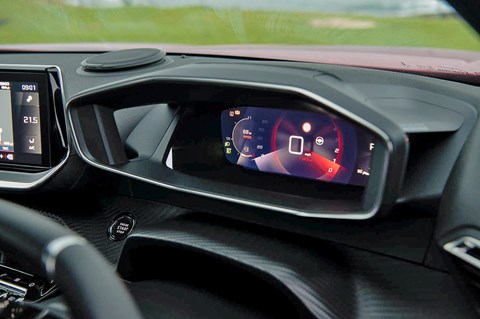
Any clever stuff?
Peugeot's powertrain approach might not be all that clever – plenty of engineers will point out that an EV optimised around that powertrain stands a good chance of being both lighter and more space-efficient – but in these uncertain times it's a laudably flexible approach. Holographic driver instruments are straight outta Star Trek.
Which version is this?
One-from-the-top GT Line with the middling petrol engine, the 130PS version of the turbo triple that can also be had with 100PS and 155PS outputs. While GT Line comes with some good stuff as standard, the bigger touchscreen's only a £650 (or £15 a month on PCP) option.
Read our Peugeot 2008 review
VW T-Cross: pre-flight briefing
Why is it here?
Because you can't have a group test of mainstream small cars without a Volkswagen in it, and because the boxy, conventional T-Cross provides a no-frills antidote to the likes of the swoopy, wish-I-was-a-small-sports-coupe-like-the-old-Puma Puma. Priced from just over £17k, the MQB-based T-Cross can be spec'd right up to a posh R-Line with a meaty 1.5 petrol or 1.6 diesel engine.
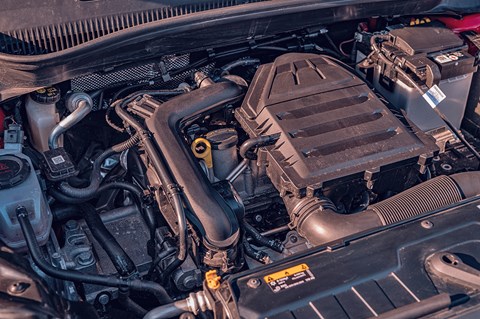
Any clever stuff?
10.25-inch Active Info Display digital instrumentation is pretty and works well once your brain's worked out which of the 18 (18!) steering-wheel buttons (nine per spoke) does what. It's a £375 option you should go for. Elsewhere there's little that breaks any new ground, but you get a thoroughly modern engine with cylinder deactivation and handy tech like active cruise, front assist with emergency braking and rear traffic alert.
Which version is this?
One-from-the-top SEL trim level with a 115PS engine and seven- speed twin-clutch 'box, further buffed with 18-inch wheels.
Read our VW T-Cross review
Ford Puma: it's like a baby Porsche Macan!
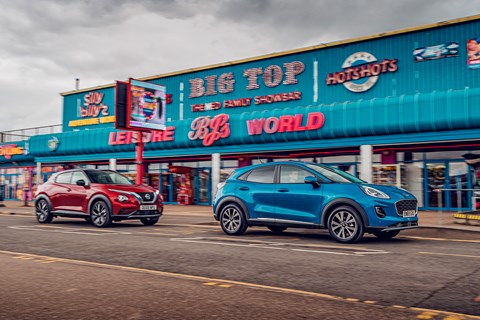
Maybe it's the early start. Maybe it's the mind-scrambling effects of both an early start and a Skegness McDonald's breakfast. Whatever, I definitely just uttered those words.
The visual similarities between Ford's new B-segment SUV and Porsche's oh-so-capable sports SUV don't exactly slap you around the face. You're not going to confuse the two in a car park, let alone on the road. But there are echoes of the Porsche in the Ford. Both have, with no little success, spliced a few sports-car chromosomes into the crossover aesthetic's existing DNA. And both aim to do the same with the way they drive. Body control, steering precision, taut damping – must these qualities be strangers to the high-rise hatch?
First thing this morning I jumped in the Ford, ignored the entirely underwhelming interior (we'll come back to it, but suffice to say the Puma's cockpit doesn't come off well next to the Peugeot's... or the VW's. Or the Juke's...) and, phone paired with the Sync infotainment in moments, got moving. Those rakish looks make for a snug feel inside (though rear visibility is almost Lamborghini-esque; Huracan, not Urus) and the driving position's good; a comfortable middle ground between the hot-hatch 2008 and the captain's-chair T-Cross.
The sun was barely above the horizon as the Ford and I parped out onto bright, windswept and deserted Lincolnshire tarmac, the going a mix of truck-laden main routes and fiendishly bumpy back roads of the kind to give chassis engineers insomnia. The Ford's ace powertrain and keen chassis made it an unlikely weapon on both.
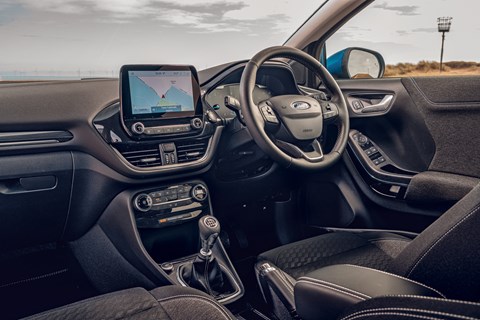
We first drove the new Puma at launch in ST-Line X 155 trim with 153bhp whipping the front wheels into a frenzy. This is the less punchy 123bhp option, but it's still the standout powertrain here. On the A16 the Ford gleefully leapfrogs trundling freight, the triple's efforts bolstered by a 48-volt mild-hybrid system. The Puma's desperate for you to clock that it's a hybrid, from the badge proudly displayed on its rump to the power meter on the dash, slap bang between the clocks, that swings back and forth as you veer from regenerative braking to e-boosting.
And desperate as you might be to dismiss such tech as a gimmick, a mile in the Ford is all it takes to appreciate that it works, the car's modest e-shove sharpening throttle response, helping mitigate lag (all these engines are turbocharged) and burnishing its numbers with a little extra economy (the Puma turns in the best mpg figure on the test). By contrast the VW's engine feels inoffensive but ordinary, the Nissan's a touch crude and the Peugeot's... Again, we'll come back to that.
Half an hour from Skegness I turn off the main roads and head north-east across mud-strewn rural lanes. The Fiesta-based Puma, with the best-powertrain gong already bagged, then makes a play for best chassis. The steering – a touch light in Normal; weightier and plain better in Sport – is the best here, as you'd expect of a company that also turned out the rather excellent current Focus. While the Puma's ride height means it can't quite summon the same beguiling cross-country fluidity, it is very good, the suspension set-up (a touch jiggly in town, despite this car riding on modest 17-inch wheels) coming into its own as you work it a little harder.

The Puma doesn't exactly relish being driven like you're charging home to clear your browsing history. Not like a Focus or, better still, a Fiesta ST. But it is the only car here interested in the task at hand. Here too the mild-hybrid system scores points, the off-throttle regen effect tugging the nose on-line and helping tip the car usefully onto its nose as you turn-in.
Fun to drive, then? Yep, and for a £23k crossover that's no mean feat. Best chassis, best engine. A baby Macan? The most Macan of these four, certainly. Your winner? Depends how much you like Fiesta interiors. The Puma has one, for better (it mostly works, and you intuitively know how it works) and for worse (lacking in feelgood design, poor lateral support to the seats, poor rear legroom). Still, before we've even sunk the first sausage and egg McMuffin of the day, the Ford's off to a flying start.
Nissan Juke: king for yesterday
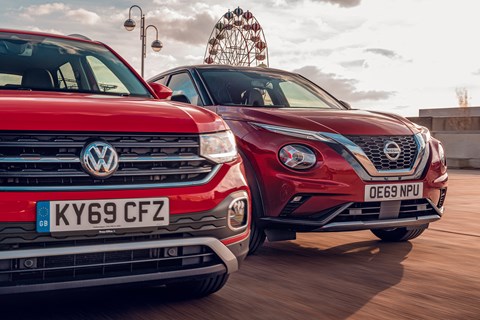
Grabbing the key to the Juke, staff writer Jake Groves's long-term test car, you have to hand it to Nissan – it looks like nothing else on the road, eye-stingingly bright winter sunshine pinging off the car's deep metallic red paint and handsome 19-inch rims. The first Juke looked like nothing else on the road but – problematically given how popular it would be – also looked nothing like a handsome example of modern automotive design. Juke 2 puts that right; this thing's cool.
Sneaking off for a drive up the coast while the others neck flat whites, first impressions are all good: great bucket-style seat, snugly comfortable cockpit, plush feel to the fabrics. Ducking past the odd dawdling Jazz, picnic rug proudly in place, there's something old-school about the Juke: big steering wheel, with an unfashionably slim and hard rim like a '50s Grand Prix car's (okay, a very tiny bit like a '50s Grand Prix car's); slightly cantankerous six-speed manual gearbox you have to work relentlessly to get anywhere; gruff, generally reluctant 999cc triple.
Later, on the blast home chasing the setting sun, Jake in the Juke will struggle to keep up with the Ford or, heaven forbid, the hot-rod Peugeot, but the Nissan (same platform as Renault's Captur and Clio, of course) is no slouch when you just need to get somewhere. The Juke generates an unlikely amount of grip, refuses to wash into the epic understeer you expect of it and, as still-damp corners come at us like frisbees on Skegness beach, the Juke clings to its composure in the face of some quite extreme provocation.
This second-generation Juke is undoubtedly a far better car to drive than its predecessor, and its chassis systems – integrated under a banner Nissan's daubed with the words Trace Control – deploy brake-based torque vectoring and modest ECU-decreed lifts of the throttle to help keep the car on the line you had in mind, rather than the one bald physics would otherwise have you describe. They work well and with admirable subtlety to make the Nissan a capable if hardly engaging cross-country tool. Better drivers (drivers like James Taylor, basically, who should be a full time GT3 race driver but fortunately – for us – lacks the personal wealth to make it happen) reckon the Juke's interventions are inconsistent and frustratingly intrusive but, to the seat of these pants, they're a lot smoother than the T-Cross's clumsy, very obvious brake-dragging efforts.
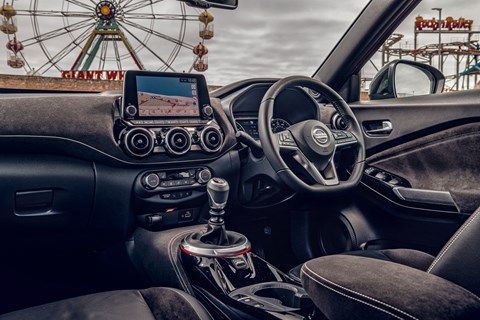
As if all of this hooning matters anyway. The first-generation Juke sold a lot better than it drove (or looked...) and, in 2018, when a first-gen Juke rolled out of the factory every 105 seconds, Sunderland built its one millionth example of the controversially styled compact crossover. The Juke all but invented this class, melding the apparently mutually exclusive crossover and coupe gene pools to deliver something like the desirability of Range Rover's equally game-changing Evoque on a fraction of the budget. The new car is a steady evolution, with less polarising (if still pretty left-field) styling, more interior space (legroom's up nearly 6cm, and the boot 20 per cent bigger) in a larger but lighter (by 23kg) and more rigid body. There's more tech, too, with ProPilot now available on the Juke, offering lane-keep assist and adaptive cruise.
Perhaps the biggest leap forward is inside. This – at the risk of damning with faint praise – is the best interior of any Nissan to date, with some plush, decidedly un-Nissan materials and just enough quirky design to elevate the space beyond that of a more workaday Qashqai or X-Trail. The VW feels airier, the Peugeot more exciting, but the Juke's cockpit is a strong combination of sound ergonomics, appealing design and quality materials. If only the manual gearbox was as sweet to use as the Peugeot's or the Ford's.
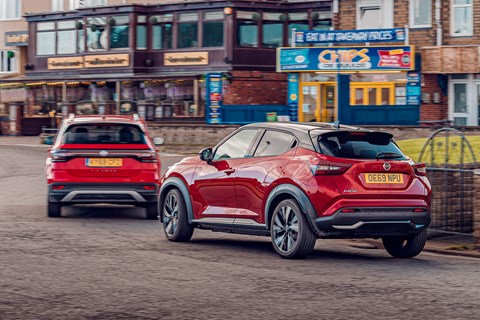
The Juke range kicks off with bum-basic Visia trim (from £17,395) but Acenta is surely as low as anyone will go, bringing a standard eight-inch touchscreen, 17-inch wheels and CarPlay/Android Auto connectivity. Top-spec Tekna (from £22,495) and Tekna+ cars get the 19-inch wheels the car really needs, the Heat pack and the all-important Bose Personal Plus audio. The system's essentially speakers in the front-seat headrests that up the audio system's surround fidelity or, if you're into Kirsty-era Desert Island Discs, make it sound like she's sitting behind you whispering sweet Scottish nothings right into your ear.
The Juke, then, is the original. The best? It's come a long way since its flawed but outlandishly successful debut. But, up against far fresher, more ambitious rivals, it hasn't come as far as it needed to.
Peugeot 2008: the lion king
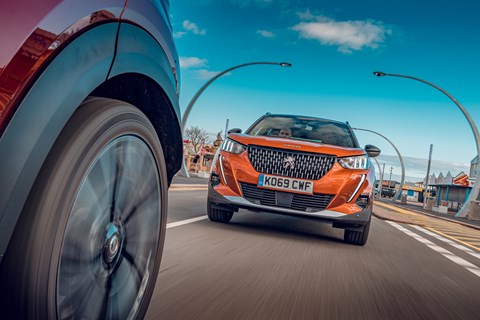
There's no easy way to say this, so I'll just come out with it: this is a £27,600 Peugeot 2008. You could get a bigger, far faster Ford Focus ST for £2k more. Less money buys a brand new Mk8 Golf hatchback with the 148bhp 1.5-litre Evo four-cylinder engine and some very lovely metallic yellow paint. Ouch.
The 'issue' is this car's GT Line trim (18-inch wheels, reversing camera, 10-inch touchscreen, heated seats) and its 128bhp version of the 1.2-litre PureTech triple. All of which makes our Peugeot something of a hot rod in this company, and outlandishly expensive. More comparable would be Allure trim (smaller touchscreen, smaller wheels, slightly less exterior funk) with either this engine (from £23,550) or the tiddler, the 100PS (99bhp) petrol (from £22,350). Choice is now Peugeot's modus operandi and the 2008 a shining exemplar for that policy, with powertrain options that stretch right the way from the little petrol through diesels to battery-electric. The latter, in a top-spec GT car, will cost you nearly £38k up front or £488 a month.
So the 2008 costs a million dollars, give or take. Fortunately, it also looks it. On the seafront at Skegness, a merciless wind whipping off the sea even if the offshore wind farm seems entirely uninterested, the Peugeot looks every inch the escaped concept car, light rippling off its geometric surfaces and setting ablaze the Fusion Orange paint. The metalwork is seriously svelte for a B-segment SUV, the car – on handsome wheels and stuffed with bold, contrasting detailing like the black pillars and roof – confident in its skin like Peugeots weren't for far too long.
Inside it's the same deal. The originality and flair on show here make you wonder if VW's interior designers might only work part-time. We find a fabulous modern interpretation of houndstooth cloth on the seat fabric, a neat touchscreen (though the reversing camera is oddly low-resolution, like that old Nokia you keep in a drawer 'just in case'), dramatically scalloped surfaces, faux carbonfibre, the cool-as-hell layered driver's display (looks like a 3D hologram; actually isn't) and funky aluminium toggle switches like you're switching fuel tanks or lowering your landing gear in an F-35 fighter, not just turning off your rear screen de-mister.
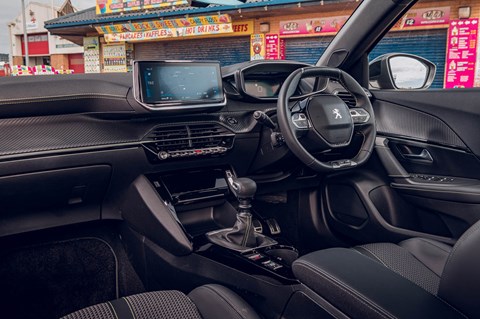
True fact: Jake was born in a DTM race car, and always sets his driver's seat subterranean. But even bumping the chair up a few notches it's striking just how low-set and hatch-like the Peugeot's driving position is after, say, the VW. The effect is heightened by the tiny steering wheel, which feels great even if it's connected to an almost scarily over-assisted rack.
Punting through town in search of clearer roads beyond, there's an infectious enthusiasm to the Peugeot that, like its 208 sibling, recalls past glories. The bagel of a steering wheel gives the car an unlikely sense of agility and this, together with the engine's punch and the perfectly weighted pedals and shift action (we have the six-speed manual; there is an eight-speed auto option), makes the 2008 a joy to drive. The chassis too acquits itself well, riding nicely. If ultimately it's not as keen as the Ford, then it is at least as keen as a crossover needs to be. And all the while there's a plush edge to its damping the Puma can't help but wish it had.
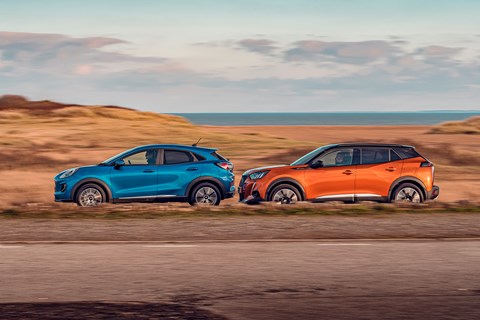
Handsome, characterful and good to drive – the 2008's top dog, surely? Almost. The engine, while potent in this company, is rougher than a three-day hangover, sounding for all the world like a diesel on start-up and running with plenty of mild vibration at several combinations of gear and cruising speed. More powerful and lesser versions of the same engine are available, though none are the last word in refinement and all use the same PSA starter button which, like an iPhone being powered down, asks that you hold it down for what feels like half an hour.
Then there's the cramped footwell. Who knows if the transmission tunnel intrusion is a product of having to package the auto gearbox or the electric powertrain option but, together with the widely spaced pedals, it leaves nowhere for your left foot to go when it's not on clutch-pedal duty. Reason enough to find the readies for the eight-speed auto, offered with the 130PS (128bhp) petrol on entry-level Active cars and the only transmission on top-spec GT cars, with their 155PS (153bhp) petrol. A shame, though, given the manual 'box is a peach. Pretentious but slim driving plimsolls, like you're Senna nipping to Sainsbury's? It's an option.
VW T-Cross: honesty is the best policy
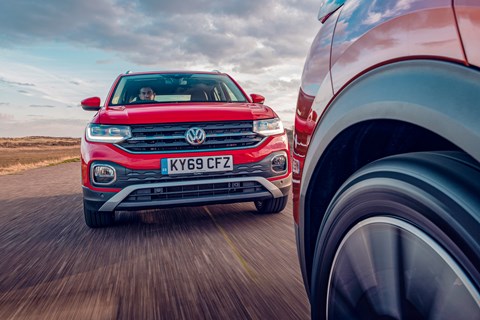
You're a suspension engineer, tasked with setting up the new T-Cross, little brother to VW's T-Roc and effectively a high-rise Polo. Given the car's likely usage and buying demographic, you'd plump for something fairly, well, plump, no? Some barely-there spring rates to soak up the urban lumps and damping like an old sofa? Perfect.
Apparently not. Instead the T-Cross prizes body control above all else – hang the crashy ride! – and loves being flung at lumpy, bump-riddled byways like a WRC car. And if the boot full of hardy perennials ends up looking like a scale model of the Somme, well, so be it. Weird.
This firm, almost unyielding suspension calibration feels accidental (the big 18-inch wheels on this car surely don't help the T-Cross's paucity of pliancy) – not an accusation you can level at any other aspect of the Volkswagen. A touch forgettable it may be, and certainly the T-Cross is almost painfully derivative next to the 2008's bold Gallic flourishes, but it feels every inch the holistically conceived, thoroughly engineered and well-resolved product the badge suggests it should be.
Where the Puma and 2008 drop you low, giving hot-hatch pilots a reassuringly reclined driving position, the T-Cross is unapologetically a small SUV. You sit bolt upright, with more rear legroom than the Juke or the Puma (VW is convinced this is what buyers want, and it'd know), and survey a cockpit which, while cheap-feeling in places compared with other, bigger VWs, feels fabulously well-crafted and luxurious in this company. The eight-inch touchscreen is glossy and responsive and the upper dash surfaces, with their faux carbonfibre sheen, help the car feel about twice as expensive as it is. And the driving position, while remote and lofty for roundabout antics, is sound and immensely relaxing.

Remember when all this was fields, and small cars were thrashy tin boxes about as relaxing to pilot as the Wright brothers' first flyer? They're gone. You could put in a solid day in this, no bother.
Crash! Bang! Maybe it's the lack of investment in local infrastructure, maybe it's the boy racers shaving tenths, but Skegness's roundabouts are rough like a badger's backside, ruthlessly highlighting the T-Cross's only significant dynamic foible: that entirely un-SUV ride quality. What's the point of sitting high, with miles of suspension travel, only for wheel movement to pass almost unchecked to the cabin? Weird.
The VW's only significant dynamic foible? Pretty much, though the dual-clutch gearbox isn't the syrupy unfair advantage you might think. In Drive, the throttle response is painfully lethargic and dim-witted, with what feels like whole inches of pedal travel failing to elicit anything from the little triple in the engine bay. So you try the S transmission setting, which replaces that lethargy with a light-switch take-off so hard to modulate that the aforementioned boy racers take your every traffic-light departure as an unlikely challenge from Postman Pat's smart new VW.
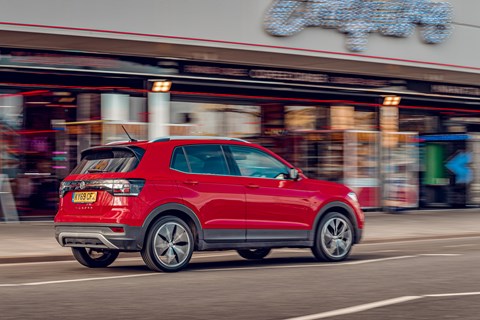
As ever, the right spec will help. This T-Cross looks fabulous, with its crisp surfaces, Cayenne-esque rear light bar and mini-Touareg air of sophisticated refinement. At the sub-£20k (from £17,395) S trim level your only powertrain option is the 95PS engine and a five-speed manual 'box (no doll, but a better bet than the twin-clutcher and a better fit with a car this size). Head up to SE trim and this pokier engine becomes available, with a choice of five- or six-speed manuals or the twin-clutch auto, while buyers of top-spec SEL and R-Line cars can choose VW's fine 1.5-litre TSI Evo or, heaven forbid, a 1.6 TDI. The sweet spot? This engine, the 1.0-litre TSI with 115PS, and the six-speed manual. Go with the standard 17-inch rims, leave the handsome range of 18s well alone and you'll be laughing.
James Taylor, who drove the T-Cross first on its launch, nips off in the VW for a round of coffees mid-afternoon, just as I'm furiously evaluating boot capacity and rear-seat legroom. And 20 minutes later he's back. 'I mean, it's bland. But it's probably also the most capable car here.'
As is often the case with VWs, the longer you spend in its company, the more you think he might be right. Where the others try hard to make your little SUV look and feel like a weird kind of high-rise coupe hatch, there's a refreshing honesty to the T-Cross. It's boxy. It sits high and four-square like a sculptural shipping container. It's roomy inside, front and rear. The rear screen doesn't slope, so you could persuade a dog into the boot. It is the full ready-for-anything family SUV, just with town-friendly dimensions and a wallet-friendly price. It's almost like VW's really good at making cars, with the economies of scale to elevate the ordinary to something a little more polished and desirable...
Ford Puma review by our sister website CarZing
The final reckoning
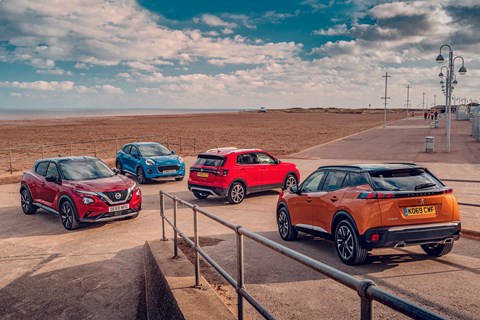
In essence, the compact crossover is a very practical proposition. The three-door RAV4s (generations one and two), while hardly pulse-spikers, remain the used car of choice among gardening-obsessed retirees because they make so much sense: compact enough to be easy to drive and park, ergonomically suited to high-mileage bodies, and with a boot to swallow a hard day's hedge trimmings.
But the compact crossover's gone mainstream, and the mainstream demands a decent wedge of desirability with its practicality. Most desirable here is the Peugeot, its knockout design inside and out enough to snare hearts before you've so much as put it in gear. Do that and you'll find a car that, while not ultimately as good to drive as the Ford, offers a capable chassis together with tonnes of character.
Peugeot has rediscovered the art of design and engineering character, of creating cars that don't feel like anything else (in a good way), and in this market in particular that isn't to be sniffed at. Just make sure you get on with the driving position, the cramped footwell and the tiny steering wheel – for some they'll be deal-breakers, and ultimately they're enough to see the 2008 to second place.
The winner's the Ford; a car to enjoy driving, even if most buyers won't care. It's also clever, efficient and practical – qualities to help you overlook the entirely uninspired interior design. Sure, it's not a Porsche Macan. But for half the money it's not a bad impression of one.
Duking it out for the right not to come last are the VW and the Juke. The T-Cross is not one of Wolfsburg's most inspired machines but there's much to commend it, not least the beautiful build quality, the nicely executed interior and the fact that, uniquely in this company, it's a proud SUV – four-square, immensely comfortable, laudably honest and, in the right spec, a mini-Touareg for a fraction of the outlay.
The Juke's not a bad car but it also does nothing better than the myriad alternatives, not least these three rivals. Most will buy on the exterior design alone. Waverers who make it to a showroom will sign up when they sit in it. But the rest of us are better off looking elsewhere for our ready-for-anything, not-four-wheel-drive baby SUV.
Puma vs Juke vs 2008 vs T-Cross: verdict
First place: Ford Puma
Great powertrain in a car far better to drive than it needs to be. Not special, but very good.
Second place: Peugeot 2008
Like your crossovers to feel like sorted hatchbacks? Then step this way. And this Pug has funk.
Third place: VW T-Cross
Unrepentantly a mini-SUV, so bang-on if you're not into the crossover/coupe vibe. Tepid but capable.
Fourth place: Nissan Juke
Brand new yet already feels short on ambition. With any luck, future derivatives will put that right.
Check out more CAR comparison tests here